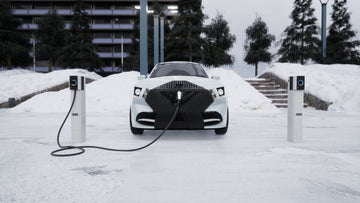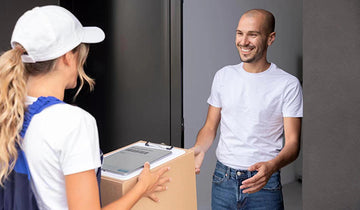
Cold winter means wrapping up a big padded jacket and stepping on snow boots! Don’t forget to take good care of your beloved car after winter equipment is complete~ Today, let’s popularize the common sense of winter car use, car owners, listen carefully! ! !
When it comes to the common sense of car use and maintenance in winter, I believe everyone can tell one or two points. If you are an old hand, you can definitely talk about it for a long time. But when it comes to new energy vehicles, it may "spread your hands". Now, more and more people choose to buy electric vehicles, so how much do you know about the common sense of charging and using electric vehicles in winter?
Fully Warm Up the Car
The battery activity of new energy vehicles is relatively low in winter, and warming up the car in advance in a low temperature environment can make the power battery reach the ideal working temperature. Therefore, new energy vehicles also need to be properly warmed up. If the car is not warmed up, it will affect the cruising range, because direct and violent driving will result in high power consumption, low speed, and will reduce the cruising range. Under the same power consumption, a battery that has been fully heated by a hot car runs faster than a cold battery that has not been heated.
When electric car is warming up, it is not idling on the spot, but driving at a low speed to achieve the purpose of warming up the car. When standing still, the battery does not work at all. Only during slow driving can the coolant in the battery gradually heat up. Be careful not to accelerate or decelerate rapidly during this process.
Precautions for Charging
Charging in winter to ensure that the tip of the gun is dry, it is recommended to charge slowly
New energy vehicles are mainly divided into plug-in hybrid vehicles and pure electric vehicles. Regardless of the power mode, you should ensure that the tip of the gun is dry and clean when charging in winter. If charging is performed when the charging plug is dusty or wet, it may cause damage to the vehicle. Therefore, when using a public EVCS charging pile in a large parking lot, you should pay attention to whether the charging plug is clean.
AC slow charging is recommended for daily use, especially when using public charging piles outdoors which maybe including come Tesla destination charger. Because slow charging can better protect the battery pack and prolong the life of the battery pack than fast charging. Reasonable allocation of fast charging and slow charging is the key to maintaining the battery pack.
Do not discharge deeply, and charge regularly even if it is idle for a long time
It is suggested that you should try to avoid frequent deep discharge and pay attention to the power of the car, but it is still possible to recharge the battery once in a while to stimulate the activity of the battery. Like the battery of a fuel vehicle, the vehicle will lose power if it is idle for a long time, which will cause great damage to the battery. For new energy vehicles, this is even more fatal. Therefore, even if the car is idle, you should always check the battery and replenish it in time. This will ensure that the battery is in a healthy state.
In winter, you might encounter a situation where your EV showed 70% battery the day before, but after sitting overnight, the gauge seems to indicate a "leakage"! Fear not, this is a common phenomenon caused by low temperature, not an actual leak. When an electric vehicle is running, the battery is constantly discharging and generates heat. This heat keeps the battery temperature up, resulting in a higher voltage and seemingly higher remaining power. However, after a cold night parked outdoors, especially when using a Level 2 EV charger, the battery cools down significantly. This drop in temperature lowers the voltage, prompting the Battery Management System (BMS) to automatically adjust the displayed power and cruising range. This is just the BMS reflecting a more accurate range based on the battery's current condition in the cold.
Precautions for Using A Car

Reasonable storage of vehicles
In winter, try to park the vehicle in the garage if possible, or take certain measures to keep warm and prevent freezing, such as covering it with a warm tarpaulin to ensure battery activity and battery capacity.
Try to avoid slamming on the gas pedal
In winter, when the vehicle is starting, carrying people, or going uphill, try to avoid slamming on the accelerator to accelerate, it will cause a large current discharge. Driving in winter should be driven at a constant speed to keep the battery healthy
Don't slam the steering wheel
When driving on a slippery road, if you slam the steering wheel, you will lose steering control in an instant, and the vehicle will also cause accidents due to inertial sliding. Whenever you are driving on a slippery road, you should slow down and turn the steering wheel lightly.
Select click brake
When driving on icy and snowy roads in winter, if you step on the brakes directly, the vehicle will easily lose control. If you want to control the vehicle to the maximum while driving, you must perform continuous point braking, so that the braking effect is the best.
Clean up the body dirt in time
Timely cleaning of car body dirt is a problem that needs attention in every season, but it is especially important in winter. Some car owners will use deicing agent to quickly melt snow after snowfall, but some components of deicing agent may corrode the paint surface on the car. In addition, for ev owners, the melted snow may also freeze around the EV charger port. If it is not cleaned up in time, it will easily cause short circuit and leakage during charging. Dirt and snow are necessary for winter driving safety.
Common Problems with evs in winter
- Antifreeze is used, but the motor or electronically controlled cooling system fails, resulting in motor damage --> antifreeze failure
- Vehicle lights are dimmed in foggy weather in winter --> bulb aging
- The wiper is deformed or the windshield is frozen --> the glass water is not suitable for low temperature weather, and it freezes below zero
- Sudden short circuit of current, even spontaneous combustion --> spontaneous combustion caused by dry winter, or line damage
- Driving skidding in rainy and snowy weather --> tire friction coefficient becomes lower at low temperature, and tire pressure is unstable
Master Your Electric Vehicle in Winter!
The crisp winter air might call for a cozy jacket and sturdy boots, but your electric vehicle (EV) needs some TLC too! While seasoned car owners have winter maintenance routines down pat, new EV drivers might feel lost in the cold. Here's a breakdown of key points to keep your electric car happy and humming through the winter months:
Charging Smart:
- Warm Up, Then Charge: Just like your muscles, your EV battery performs better when warm. Avoid plugging in immediately after parking; a short, low-speed drive helps the battery reach optimal temperature.
- Dry is Best: Snowy days are charming, but ensure the charging connector is dry and free of debris before plugging in.
- Slow and Steady Wins the Race: For daily charging, especially outdoors, opt for AC slow charging. It's gentler on your battery than fast charging, promoting its longevity.
- Don't Let it Drop Too Low: Avoid deep discharges. Regularly top up your battery, even if the car is idle. Just like a phone, a healthy EV battery needs periodic "refueling."
What to do if Battery Blues?
- Winter "Leakage": Don't fret if your EV shows less charge after a cold night. This is normal! The battery cools down, lowering voltage. The displayed range adjusts accordingly.
- Storage Matters: If possible, park your EV in a garage or covered area. This helps maintain battery activity and capacity.
Driving Savvy for Winter Safety
- Shelter from the Storm: When possible, park your EV in a garage or covered area. This helps maintain battery activity and capacity.
- Gentle on the Gas: Avoid slamming the accelerator, especially when starting, carrying passengers, or climbing hills. This creates a surge in power consumption, straining the battery.
- Steering with Care: On slippery roads, resist the urge to jerk the steering wheel. This can lead to loss of control. Take corners gently and maintain a steady speed.
- Click, Don't Slam: When braking on icy roads, avoid slamming the brakes. Use "point braking" – applying and releasing pressure repeatedly – for optimal control.
- Clean is Key: Regularly remove dirt and snow from your car's body. Deicing agents can corrode paint, and frozen snow around the charging port can cause issues.
Bonus Tip: While antifreeze protects your engine coolant in traditional vehicles, similar problems can occur in EVs due to motor or cooling system malfunctions. Be mindful of any warning signs.
Remember, mastering these winter car care practices will ensure your EV stays happy and healthy, keeping you cruising confidently through the colder months.




